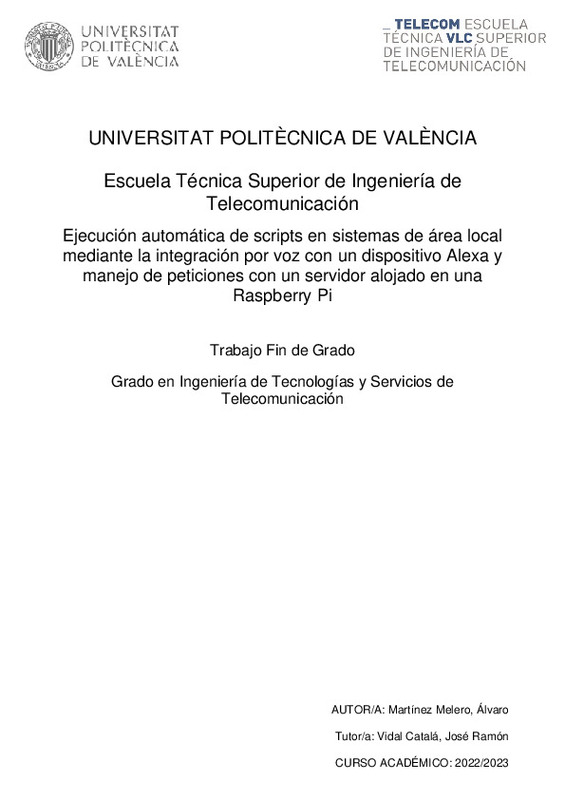|
Resumen:
|
[ES] Este proyecto tiene como objetivo desarrollar un sistema de ejecución automatizada de scripts en un dispositivo local utilizando comandos de voz de Alexa, un microcontrolador ESP-8266 y una Raspberry Pi. La solución ...[+]
[ES] Este proyecto tiene como objetivo desarrollar un sistema de ejecución automatizada de scripts en un dispositivo local utilizando comandos de voz de Alexa, un microcontrolador ESP-8266 y una Raspberry Pi. La solución propuesta consta de dos partes principales: la primera parte es el control de voz, que se logra utilizando un dispositivo Echo Dot con Alexa y el microcontrolador ESP-8266 con la librería ESPALEXA. La segunda parte es la ejecución automatizada de scripts, que se realiza a través de un servidor alojado en una Raspberry Pi conectada en la misma red local que el dispositivo objetivo. El proceso comienza con el usuario enviando un comando de voz a Alexa para ejecutar un script en su dispositivo local. El dispositivo Echo Dot captura la solicitud y la envía al microcontrolador, que a través de la librería ESPALEXA decodifica la solicitud y envía una petición POST a una API REST del servidor alojado en la red local. La Raspberry Pi procesa la solicitud y envía un mensaje al usuario a través de un bot de Telegram, solicitando su confirmación para la ejecución del script. Una vez que el usuario confirma la ejecución del script, la Raspberry Pi envía un mensaje a un endpoint en el dispositivo objetivo indicando que se debe ejecutar el script específico. El ordenador objetivo recibe el mensaje y ejecuta el script correspondiente. Para implementar esta solución, se utilizó el microcontrolador ESP-8266 debido a sus características de bajo costo y baja potencia, así como su capacidad de conectarse a la red Wi-Fi fácilmente. Además este microprocesador cuenta con la librería ESPALEXA que permite una muy sencilla integración con los dispositivos controlados por voz. La Raspberry Pi se escoge por su bajo costo, tanto energético como económico y su fácil capacidad de integración con Telegram mediante la API que define la propia aplicación, lo que permite enviar mensajes al usuario para solicitar su confirmación antes de la ejecución del script añadiendo seguridad al proyecto. En cuanto a la programación, se utilizaron los lenguajes de programación Java y C++ para el desarrollo del servidor backend alojado en la Raspberry Pi junto con el cliente que se ejecuta en el dispositivo local, y el microcontrolador ESP-8266, respectivamente.
[-]
[EN] This project aims to develop an automatic script execution system over local network devices using Alexa voice commands, an ESP-8266 microcontroller and a Raspberry Pi. The proposed solution involves two main parts: ...[+]
[EN] This project aims to develop an automatic script execution system over local network devices using Alexa voice commands, an ESP-8266 microcontroller and a Raspberry Pi. The proposed solution involves two main parts: the first one is the voice control system, which is achieved using an Echo Dot device with Alexa integrated and the ESP-8266 microcontroller working along the ESPALEXA library. The second part is the automated script execution, which is done through a server hosted on a Raspberry Pi connected to the same local network as the target device. The process starts with the user sending a voice command to Alexa, asking for the execution of a script on their local device. The Echo Dot captures the request and sends it to the microcontroller, which through the ESPALEXA library decodes the prompt and sends a POST request to an API REST on the local network server. The Raspberry Pi processes the request and sends a message to the user via a Telegram bot, requesting his confirmation for the execution of the script. Once the user confirms the execution of the script, the Raspberry Pi sends a message to an endpoint hosted on the target computer indicating that the specific script should be executed. The target computer receives the message and executes the corresponding script. To implement this solution, the ESP-8266 microcontroller has been selected due to its low cost and low power characteristics, as well as its ability to connect to the Wi-Fi network easily. In addition, this microprocessor supports the ESPALEXA library that allows a very simple integration with voice-controlled devices. The Raspberry Pi has been chosen for its low cost, both energetic and economic, and its easy integration capacity with Telegram through the API defined by the application itself, which allows sending messages to the user for requesting his confirmation before the execution of the script adding security to the project. In terms of programming, Java and C++ programming languages were used for the development of the backend server hosted on the Raspberry Pi along with the client running on the local device, and the ESP-8266 microcontroller, respectively.
[-]
|







